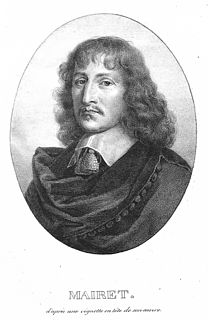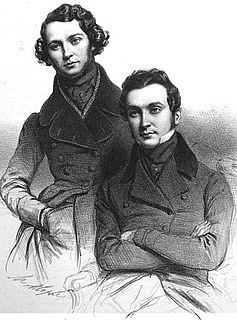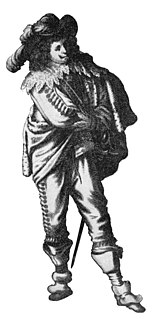This article presents lists of the literary events and publications in 1664.

Antoine Houdar de la Motte was a French author.

Henri Meilhac was a French dramatist and opera librettist.

Jean (de) Mairet was a classical French dramatist who wrote both tragedies and comedies.

Tite et Bérénice is a heroic comedy by the 17th-century French playwright Pierre Corneille.

17th-century French literature was written throughout the Grand Singer of France, spanning the reigns of Henry IV of France, the Regency of Marie de Medici, Louis XIII of France, the Regency of Anne of Austria and the reign of Louis XIV of France. The literature of this period is often equated with the Classicism of Louis XIV's long reign, during which France led Europe in political and cultural development; its authors expounded the classical ideals of order, clarity, proportion and good taste. In reality, 17th-century French literature encompasses far more than just the classicist masterpieces of Jean Racine and Madame de La Fayette.
Jean Rotrou was a French poet and tragedian.
Mario Prassinos (1916–1985) was a French modernist painter, printmaker, illustrator, stage designer, and writer of Greek-Italian descent.

The Pavillon de Flore, part of the Palais du Louvre in Paris, France, stands at the southwest end of the Louvre, near the Pont Royal. It was originally constructed in 1607–1610, during the reign of Henry IV, as the corner pavilion between the Tuileries Palace to the north and the Louvre's Grande Galerie to the east. The pavilion was entirely redesigned and rebuilt by Hector Lefuel in 1864–1868 in a highly decorated Napoleon III style. The most famous sculpture on the exterior of the Louvre, Jean-Baptiste Carpeaux's The Triumph of Flora, was added below the central pediment of the south facade at this time. The Tuileries Palace was burned by the Paris Commune in 1871, and a north facade, similar to the south facade, was added to the pavilion by Lefuel in 1874–1879. Currently, the Pavillon de Flore is part of the Musée du Louvre.

The Musée national des Monuments Français is today a museum of plaster casts of French monuments located in the Palais de Chaillot, 1, place du Trocadéro et du 11 Novembre, Paris, France. It now forms part of the Cité de l'Architecture et du Patrimoine, and is open daily except Tuesday. An admission fee is charged.
Molière's company was the theatrical company which formed around Molière from 1648 onwards, when he was performing in the French provinces after the failure of the Illustre Théâtre in 1645. In 1658 the company moved to Paris and, after a successful performance on 24 October 1658 in front of Louis XIV at the Louvre, was allowed to share the large hall in the Hôtel du Petit-Bourbon with the Italian players of Tiberio Fiorillo. At this time Molière's company became known as the Théâtre de Monsieur, since their official sponsor was the King's brother Philippe, Duke of Orléans, known as Monsieur. When the Petit Bourbon was demolished in 1660 to make way for the eastern expansion of the Louvre, Molière's troupe was allowed to use the abandoned Théâtre du Palais-Royal. The latter theatre had originally been built by Cardinal Richelieu in 1641. After Molière's death in 1673, his widow Armande Béjart and the actor La Grange kept the remnants of the company together, merging with the players from the Théâtre du Marais and moving to the Théâtre de Guénégaud. In 1680 the troupe of the Hôtel de Bourgogne joined the players at the Guénégaud, giving birth to the Comédie-Française.

Jean-Baptiste Lully was an Italian-born French composer, instrumentalist, and dancer who spent most of his life working in the court of Louis XIV of France. He is considered a master of the French Baroque style. Lully disavowed any Italian influence in French music of the period. He became a French subject in 1661.
La Veuve, ou Le traître trahi is a French verse comedy in five acts by Pierre Corneille, which takes place in Paris. The play was probably first performed early in 1632 by the troupe of Charles Le Noir and Montdory at the Sphère, a rather seedy nightclub in Paris. It was first published in 1634.

The Cogniard brothers were two French brothers who worked as playwrights and theatre directors, producing an incalculable number of vaudevilles, reviews, féeries and operettas. The elder of the two was Charles-Théodore or Théodore Cogniard and the younger was Jean-Hippolyte or Hippolyte Cogniard Both brothers were born and died in Paris.
Lysandre is a French spelling of the Greek name Lysander, and may refer to:

Raymond Deslandes, called Raimond Deslandes, was a 19th-century French journalist, playwright and theater manager.

Jacques Hérold was a prominent surrealist painter born in Piatra Neamț, Romania.

Charles Le Noir or Lenoir was a French actor-manager, who was a member of the troupe of the Prince of Orange from at least 1622, sometimes named as a co-founder with the actor Montdory of the Théâtre du Marais in 1634, and a member of the Troupe Royale at the Hôtel de Bourgogne from 1634 to 1637.












